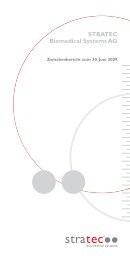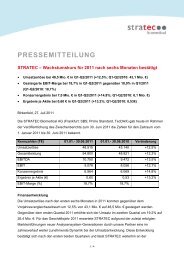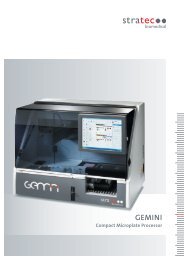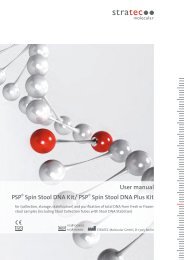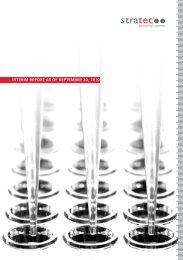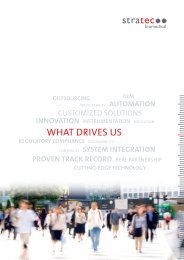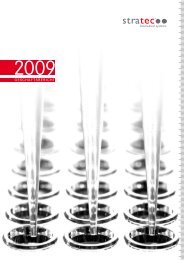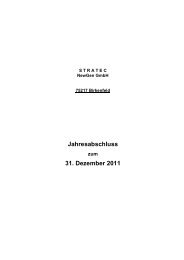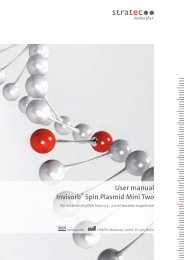annual Report 2009 - STRATEC Biomedical AG
annual Report 2009 - STRATEC Biomedical AG
annual Report 2009 - STRATEC Biomedical AG
You also want an ePaper? Increase the reach of your titles
YUMPU automatically turns print PDFs into web optimized ePapers that Google loves.
Financial assets are recognized as of the performance date at fair value, which as a general rule corresponds to cost of<br />
acquisition, plus transaction costs. Transaction costs incurred upon the acquisition of financial assets measured at fair<br />
value through profit or loss are directly recognized as expenses.<br />
In subsequent periods, financial assets are measured in accordance with the individual IAS 39 categories to which<br />
the respective assets are to be classified or have been classified. In subsequent periods, receivables are measured at<br />
amortized cost. When necessary, impairment losses are recognized for financial assets. Indications of impairment may<br />
arise, for example, from a significant deterioration in creditworthiness, a particular breach of contractual terms or the<br />
insolvency of the creditor. Credit risks are accounted for with an appropriate level of allowances.<br />
Available-for-sale financial assets and securities subsequently measured through profit or loss are measured at fair value<br />
as of the balance sheet date. Unlisted equity instruments are recognized at fair value, but only to the extent that this can<br />
be reliably determined. When this is not the case, such instruments are alternatively recognized at cost, accounting for<br />
impairment where necessary.<br />
Unrealized changes in the value of available-for-sale financial assets are recognized directly in equity in the fair value<br />
reserve within other equity until disposal, or until any significant or permanent reduction arises in the market value of<br />
such assets.<br />
<strong>STRATEC</strong> <strong>AG</strong> has not drawn on the option of designating financial assets upon initial recognition as financial assets<br />
measured at fair value through profit or loss.<br />
Financial assets are written up should the reasons for previous impairment losses recognized no longer apply, but may<br />
not be written up to any amount exceeding their amortized cost.<br />
Financial assets are retired when the contractual rights to payment in connection with the financial assets have expired<br />
or the financial assets have been assigned together with all material risks and rewards relating to ownership.<br />
Inventories<br />
Inventories include raw materials and supplies, unfinished products not relating to specific orders, finished products<br />
and customer-specific unfinished services. The costs of manufacture for unfinished and finished products include both<br />
directly allocable manufacturing wage and material expenses and a prorated share of material and production overheads,<br />
including depreciation. The costs of manufacture for unfinished services include both directly allocable manufacturing<br />
wage expenses and prorated production overheads. Sales overheads and borrowing costs are fully expensed, rather than<br />
being capitalized. Borrowing costs must generally be recognized for acquisition and manufacturing processes beginning<br />
after January 1, <strong>2009</strong> to the extent that these are incurred in the period up to completion of the relevant asset. The<br />
borrowing costs eligible for capitalization in the <strong>2009</strong> financial year were not material, as a result of which capitalization<br />
has been foregone. Inventories are measured at the lower of cost or the recoverable net selling price as of the balance<br />
sheet date. Impairment losses are recognized on outdated inventories.<br />
Future receivables from construction contracts<br />
Pursuant to IAS 11, construction contracts have been recognized at their respective percentage of completion. The<br />
aggregate amount of cumulative costs and the prorated share of earnings recognized as of the balance sheet date has<br />
been stated in the balance sheet under “Future receivables from construction contracts”. Changes in the level of future<br />
receivables have been recognized under “Sales” in the statement of comprehensive income.<br />
66 stratec Annual <strong>Report</strong> <strong>2009</strong>



